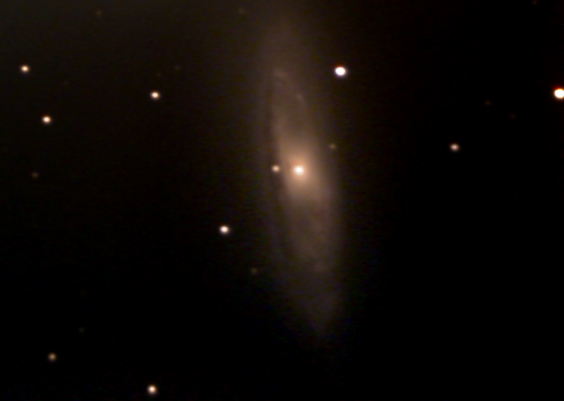
M65

RA: 11hrs 18min 54secs Dec: 13º 05' 00" Mag: 9.3 Distance: 30 million light years Constellation: Leo
One of a group of three galaxies clustered just south of the constellation Leo, the 'Leo Trio' (including M66 and NGC 3628) was discovered by Méchain in 1780 working in collaboration with Messier. The grouping is real and all three galaxies lie 30 million light years away. M65 is classed as an Sa Spiral galaxy and is viewed from the side where a prominent dark dust trail can be seen.
This photo was taken on a rare clear night in an otherwise cloudy and overcast Spring, on the night of the 3rd April 2005 with the moon in its first quarter. There was no wind and seeing quality was good. If your monitor is set on the bright side, you will see that the sky background is polluted with excessive signal 'noise' on the top edge of this picture around the galaxy. I updated Meade's Autostar Suite to ver 3.23 and Autostar Envisage (whch runs the DSI) to ver 5.85 which changed some of the settings in the programme when I came to use it this night. One of the changes was that the process of dark-subtraction was not selected where it had been the default previously. I didn't realise this until the following night when taking pictures of M96, so pictures of both M65 and M66 were of poorer quality in signal-to-noise ratio. This picture is a stack of 4 series of 21.2 sec exposures at f6.3 by Envisage with the DSI (441 seconds, 504 seconds, 609 seconds, 168 seconds) making a total exposure time of 28 minutes 42 seconds. Processing was concentrated on getting rid of the signal-noise in the sky background. This was achieved by carefully selecting out as accurately as I could, the outline of the galaxy with a feather border of 30 pixels, and then using the curves command in Photoshop to reduce the individual RGB outputs of the selection-inverse. A layer mask of the inverse image was applied to prevent over blooming of the galaxy centre and the surrounding stars during midtone enhancement which was carried out in the levels command of Photoshop. This enhancement was carried out on my properly calibrated monitor so if the image background is still too 'noisy', you need to turn down the brightness and adjust the contrast settings of your monitor.
HOME PICTURES: Deep Sky PICTURES: Solar system PICTURES: Wide field